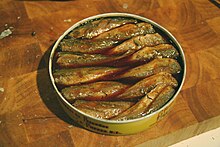
Back سمك معلب Arabic کنسرو ماهی Persian Պահածոյացված ձուկ Armenian Ikan kaleng ID Рибље конзерве Serbian ปลากระป๋อง Thai Balık konservesi Turkish Cá hộp Vietnamese 魚罐頭 Chinese Hî-á koàn-thâu ZH-MIN-NAN

Canned or tinned fish are food fish which have been processed, sealed in an airtight container such as a sealed tin can, and subjected to heat. Canning is a method of preserving food, and provides a typical shelf life ranging from one to five years. They are usually opened via a can opener, but sometimes have a pull-tab so that they can be opened by hand. In the past it was common for many cans to have a key that would be turned to peel the lid of the tin off; most predominately sardines, among others.
Fish have low acidity levels at which microbes can flourish. From a public safety point of view, foods with low acidity (pH greater than 4.6) need sterilization at high temperatures of 116–130 °C (241–266 °F). Achieving temperatures above the boiling point requires pressurized cooking.[1] After sterilization, the containing can prevents microorganisms from entering and proliferating inside. Other than sterilization, no method is dependable as a preservative. For example, the microorganism Clostridium botulinum (which causes botulism) can only be eliminated at temperatures above the boiling point.
Preservation techniques are needed to prevent spoilage and lengthen shelf life. They are designed to inhibit the activity of spoilage bacteria and the metabolic changes leading to a loss of quality. Spoilage bacteria are the specific bacteria that produce the unpleasant odours and flavours associated with spoiled fish.[2][3]
- ^ William Schafer (2009-01-09). "Home Canning Tomatoes". Extension.umn.edu. Archived from the original on July 16, 2010. Retrieved 2010-07-14.
- ^ Huss HH (1988) Quality and quality changes in fresh fish FAO Fisheries Technical Paper 348, Rome. ISBN 92-5-103507-5.
- ^ FAO: Preservation techniques Fisheries and aquaculture department, Rome. Updated 27 May 2005. Retrieved 14 March 2011.
© MMXXIII Rich X Search. We shall prevail. All rights reserved. Rich X Search